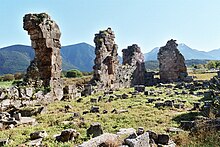Zaraka Monastery
| former Cistercian Abbey of Zaraka | |
|---|---|
 Monastery ruins, left Óros Ziría 2374 m; Lake Stymfalia to the right of the picture |
|
| location |
Peloponnese Korinthia prefecture |
| Coordinates: | 37 ° 52 '1 " N , 22 ° 27' 29" E |
| Serial number according to Janauschek |
588 |
| founding year | probably 1225 |
| Year of dissolution / annulment |
before 1275/1280 |
| Mother monastery | Monastery Hautecombe or morimond abbey |
|
Daughter monasteries |
no |
The Zaraka (Saracez) Monastery is a former Cistercian abbey in Greece . The ruins of the monastery are located on a plateau (approx. 620 m) on Lake Stymfalia between the villages of Kionia and Stymfalia ( Korinthia prefecture , northern Peloponnese ), two kilometers northwest of ancient Stymphalos .
history
The monastery was founded in the first half of the 13th century. During the time of the Frankish rule in the Fourth Crusade , Gottfried I von Villehardouin , Lord of Morea , offered in 1210 to build a house for Cistercian monks in Patras, about which nothing else is known. The request reached the Hautecombe monastery in Savoy. It is unclear whether the Isova monastery in the region of Eli , whose membership of the Cistercian order is not certain, or Zaraka emerged from this. In 1225, Gottfried I von Villehardouin asked the general chapter of the order to send a group of monks to a monastery in Achaia ( Peloponnese ). As a result of the end of Latin rule in Constantinople, the monasteries of the Western orders in Greece had to be closed by 1275 or 1280, with the exception of the Daphni monastery and a Cistercian settlement on Crete . Coin finds from the 14th century show, however, that the facility was also used later. Since 1993 more extensive excavations have been carried out by archaeologists from Toronto.
Plant and buildings
Zaraka is the best preserved Frankish monastery complex in Greece. The z. Some still upright remains show a transeptless three-aisled Gothic church with a rectangular choir, a four-bay nave with round pillars supporting the arcades with four half-columns, a round turret next to the choir and a side chapel on each side. Some of the stones come from the ancient city of Stymphalos . From the cloister south of the church a passage led directly into the church. The foundation of a bell tower can be found in the northeast of the church. The monastery had a two-story gatehouse with a barrel-vaulted passage.
Remarks
- ↑ f in Medieval Grece, Chicago 1979, p 7 After Beata Kitsiki Panagopoulos, Cistercian monasteries and mendicant., The assignment of one or the other monastery is not secured to one of the requests, while Romain Clair, Abbaye d'Hautecombe, Lyon, n.d. links the request in Hautecombe with the establishment of Zaraka
- ↑ http://www.cistercensi.info states 1268 as the year of the dissolution
literature
- Beata Kitsiki Panagopoulos: Cistercian and mendicant monasteries in medieval Greece , Chicago 1979, ISBN 0-226-64544-4 , pp. 27-42
- Sheila D. Campbell: The Cistercian Monastery of Zaraka , in: Echos du Monde Classique / Classical Views 16, 1997, 177 - 196 (with map)
- KE Salzer: Gatehouses and mother houses. A study of the Cistercian abbey of Zaraka , in: Mediaeval Studies, Toronto, 61, 1999, pp. 297-324
- E. Efthymiou: Cistercians in Byzantium: The monastery of Zaraka , MA thesis, The University of York, Department of Archeology, 1999
Web links
- arts.mun.ca Campbell, The Cistercian Monastery of Zaraka
- Certosa di Firenze website with some photos by Stephen Tobin
